2C: Cell Division in Eukaryotic & Prokaryotic Cells
1/67
There's no tags or description
Looks like no tags are added yet.
Name | Mastery | Learn | Test | Matching | Spaced |
|---|
No study sessions yet.
68 Terms
What are the phases of the cell cycle?
interphase
nuclear division (mitosis)
cell division (cytokinesis)
What are cyclins?
Chemical signals that trigger a transition from one phase of the cell cycle to another.
The length of the cell cycle is fixed/variable.
Why?
variable
It depends on environmental conditions, the cell type and the organism.
Display the phases of mitosis in the form of a diagram.
Label each phase with what happens during it.
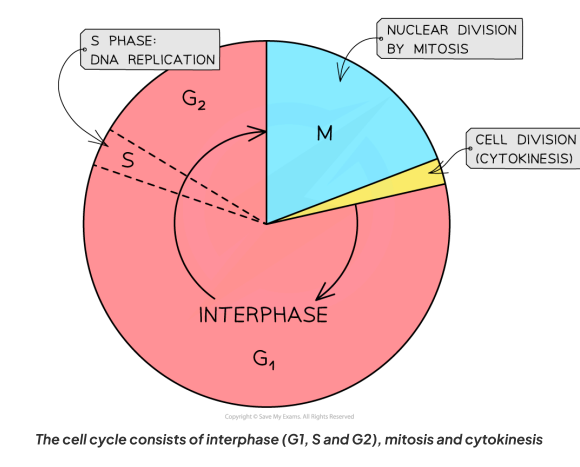

What happens during the interphase stage?
The cell increases in size and carries out normal cellular functions, e.g. synthesising proteins and replicating DNA ready for mitosis,
Interphase consists of __ phases.
What are they?
Interphase consists of 3 phases:
G1
S phase
G2
What does G stand for? (relating to G1 and G2 phase)
gap
What occurs during the G1 phase?
Cells make enzymes and other proteins required for growth
At some point during G1 a signal is received, telling the cell to divide again; at this point the cell will progress into S phase.
What does S stand for? (relating to S phase)
synthesis (of DNA)
What occurs during the S phase?
The DNA in the nucleus replicates, after which each chromosome consists of two identical sister chromatids.
The S phase is relatively short/long.
short
What occurs during the G2 phase?
The cell continues to grow and the new DNA is checked so that any errors can be repaired
Other preparations for cell division are made, e.g.the production of tubulin protein, which is used to make microtubules for the mitotic spindle
Give a table showing the phases of interphase, including a summary of each of them.
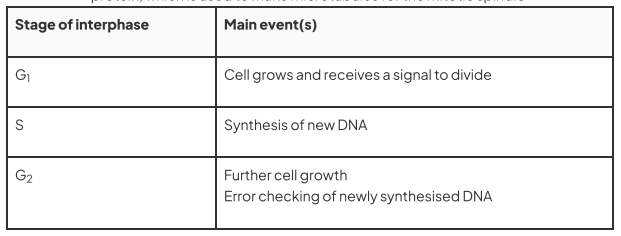

Interphase is a phase in mitosis.
True or False?
False. It is NOT.
What is mitosis?
The process of nuclear division producing two genetically identical daughter nuclei.
In mitosis, each ______ is genetically _______ to the parent _______.
In mitosis, each nucleus is genetically identical to the parent nucleus.
Give some reasons as to why mitosis is fundamental to biological processes.
Growth of multicellular organisms
Replacement and repair of cells
Asexual reproduction
Why is mitosis important relating to the growth of multicellular organisms?
The two daughter cells produced are genetically identical to one another (clones) and have the same number of chromosomes as the parent cell.
This enables unicellular zygotes (as the zygote divides by mitosis) to grow into multicellular organisms.
Growth may occur across the whole body of the organism or be confined to certain regions, such as in the meristems (growing points) of plants.
Why is mitosis important relating to the replacement & repair of cells?
Damaged tissues are repaired via mitosis, followed by cytokinesis
Continuous cell loss (e.g. skin, gut lining) requires constant cell replacement
Some animals show bof body parts (e.g. zebrafish fins, axolotl limbs)
Why is mitosis important relating to asexual reproduction?
Involves one parent, producing genetically identical offspring
In unicellular organisms (e.g. Amoeba), mitosis results in reproduction
In multicellular organisms, offspring may detach from the parent after growth e.g. runners in strawberries and budding in Hydra and yeast
What are the stages of mitosis?
Prophase
Metaphase
Anaphase
Telophase
What occurs in prophase?
Chromosomes condense (visible when stained)
Each chromosome = 2 sister chromatids joined at a centromere
Centrosomes move to opposite poles
Spindle fibres (microtubules) form from centrosomes
Nuclear envelope breaks down
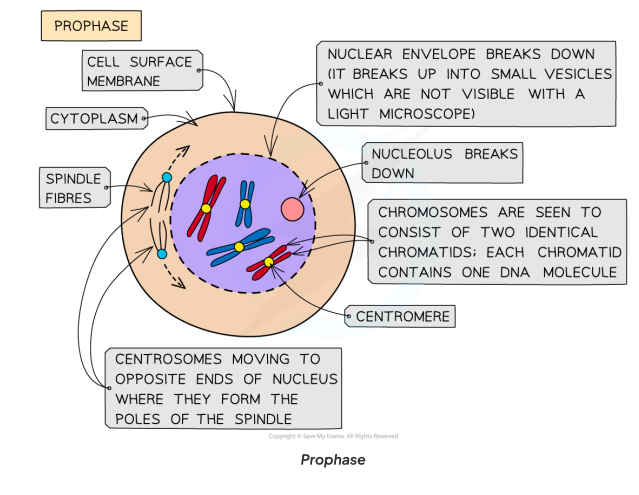
DIAGRAM IS SIMPLIFIED. AN ACTUAL ANIMAL CELL HAS MANY MORE CHROMOSOMES THAN THIS.

What occurs in metaphase?
Centrosomes are located at opposite poles of the cell
Spindle fibres are fully formed and are attached to the centromeres of the chromosomes
Chromosomes align on the metaphase plate (equator of the cell)
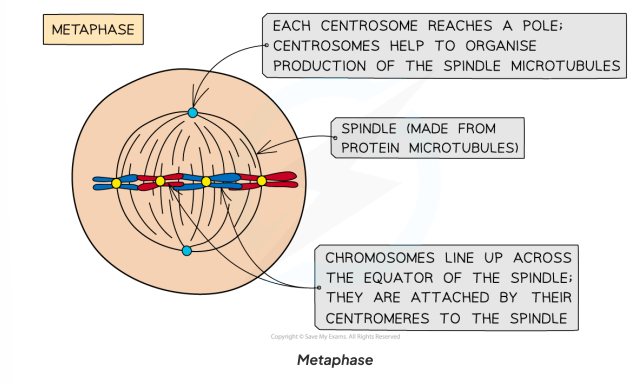

What occurs in anaphase?
Spindle fibres shorten, pulling chromatids apart
Centromeres divide, separating sister chromatids
Chromatids (now chromosomes) move to opposite poles
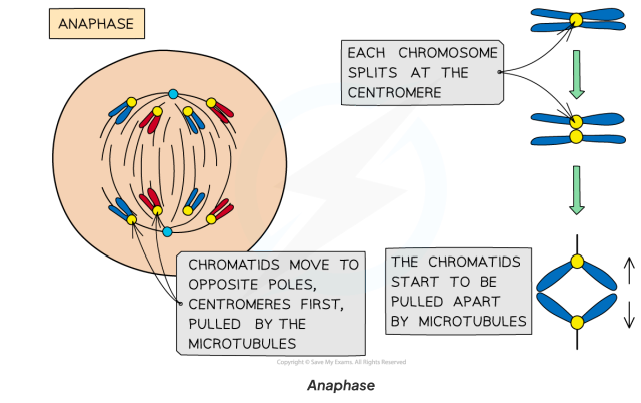

What occurs in telophase?
Chromosomes arrive at opposite poles and begin to decondense
Nuclear envelopes (nuclear membranes) begin to reform around each set of chromosomes
The spindle fibres break down
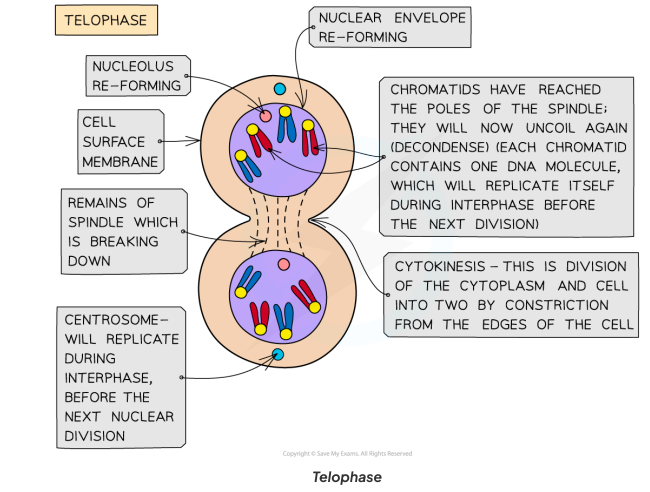

How many chromosomes do humans have?
46 chromosomes (23 pairs)
All organisms have 46 chromosomes.
True or False?
FALSE.
Remember this when answering questions!!!
How can you recognise prophase in a micrograph?
Chromosomes are visible
The nuclear envelope is breaking down


How can you recognise metaphase in a micrograph?
Chromosomes are lined up along the middle of the cell.
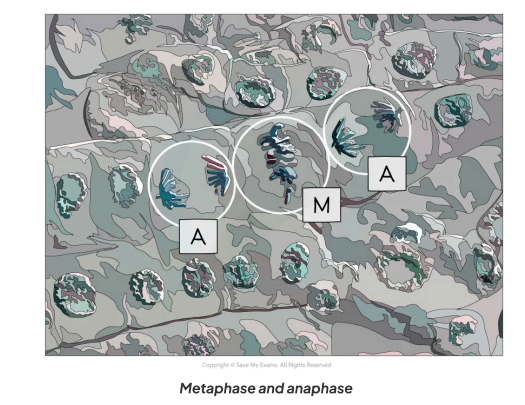

How can you recognise anaphase in a micrograph?
Chromosomes are moving away from the middle of the cell, towards opposite poles.


Hiw can you distinguish between prophase and telophase in a micrograph?
In prophase, there is only one group of chromosomes, while in telophase, there are two groups, one at each pole.
Is cytokinesis a stage of mitosis?
No.
What occurs in the cytokinesis of animal cells?
A cleavage furrow forms
The membrane pinches inwards to separate cells


What occurs in the cytokinesis of plant cells?
A cell plate forms at the metaphase plate
New cell walls are built from the cell plate to separate cells
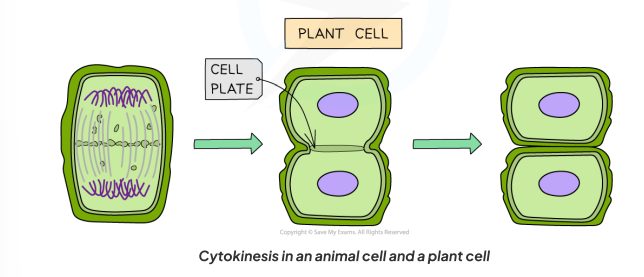

What is the mitotic index?
The proportion of cells (in a group of cells or a sample of tissue) that are undergoing mitosis.
How do you calculate mitotic index?
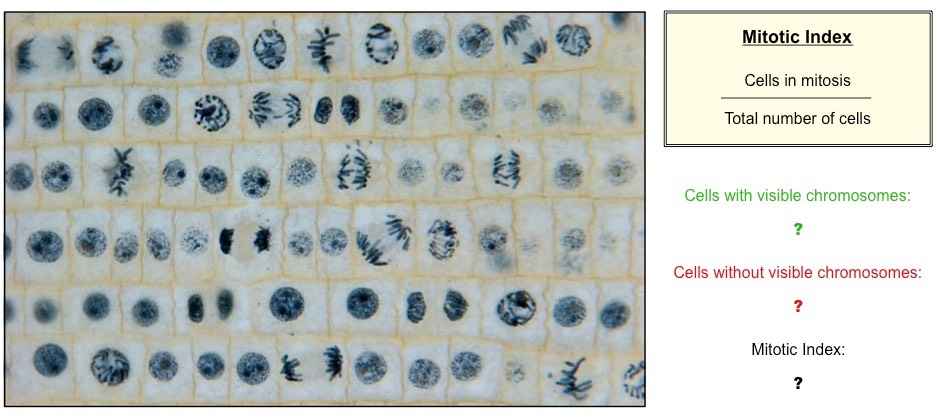
You can multiply this by 100 if your answer is required as a percentage.
A student who wanted to observe mitosis prepared a sample of cells. They counted a total of 42 cells in their sample, 32 of which had visible chromosomes.
Calculate the mitotic index forthis sample of cells (give your answerto 2 decimal places).
mitotic index = number of cells with visible chromosomes ÷ total number of cells
mitotic index = 32 ÷ 42
mitotic index = 0.76

The table below shows the number of cells in different stages of mitosis in a sample from a garlic root tip.
Calculate the mitotic index for this tissue (give your answer to 2 decimal places).
mitotic index = number of cells with visible chromosomes ÷ total number of cells
mitotic index = (prophase + metaphase + anaphase + telophase) ÷ total number of cells
mitotic index = (14 + 5 + 3 + 6) ÷ (36 + 14 + 5 + 3 + 6)
mitotic index = 28 ÷ 64
mitotic index = 0.44

The micrograph below shows a sample of cells from an onion root tip. Calculate the mitotic index for this tissue (give your answer to 2 decimal places).
Number of cells with visible chromosomes (green) = 20
Total number of cells (green + red) = 20 + 55 = 75
mitotic index = number of cells with visible chromosomes ÷ total number of cells
mitotic index = 20 ÷ 75
mitotic index = 0.27

How do you calculate magnification?
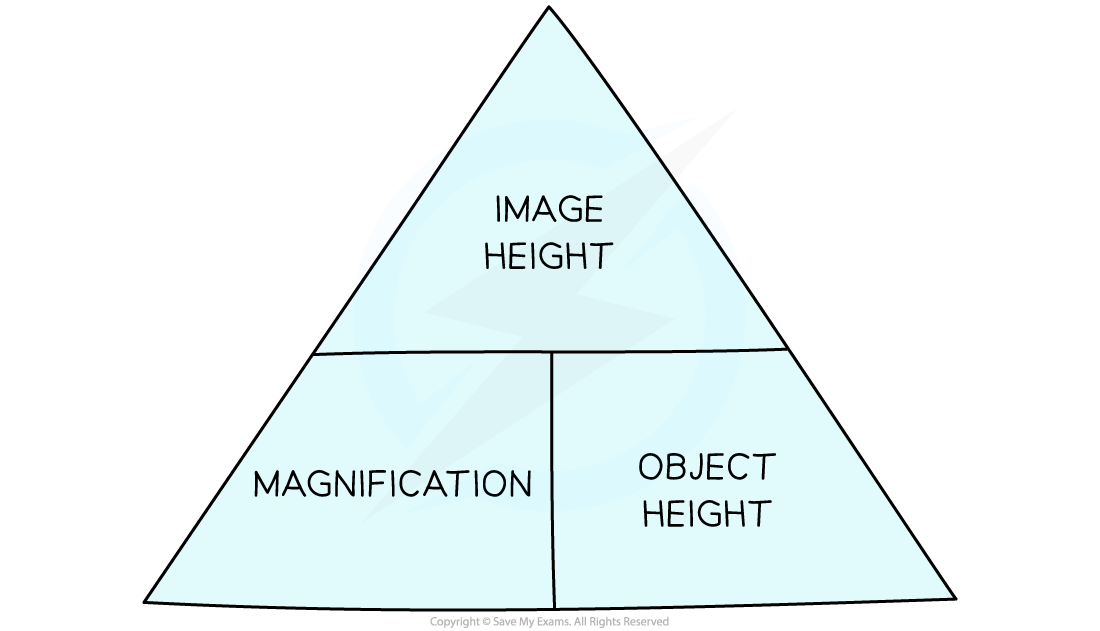
The size of cells are typically measured in what units?
micrometres
The cellular structures of cells are typically measured in what units?
micrometres or nanometres
There are ____ nanometres in a micrometre.
There are ____ micrometres in a millimetre.
There are ____ millimetres in a metre.
1000
1000
1000
Cancer results from… forming…
…uncontrolled mitosis, forming a tumour (an abnormal mass of cells).
What can lead to this uncontrolled mitosis?
Mutations in genes controlling the cell cycle, eg. oncogenes and tumour suppressing genes.
Mutations may cause… and they may prevent…
cause continuous cell division
prevent programmed cell death (apoptosis)
What are oncogenes? What is their role?
A mutated version of the normal gene called proto-oncogene. These cause the constant activation fo proteins that stimulate cell growth and division, thereby speeding up the cell cycle.
What is the role of proto-oncogenes?
Code for proteins that stimulate cell growth and differentiation.
What are tumour suppressor genes?
Tumour suppressor genes are normal genes which encode proteins that:
Repair DNA
Slow the cell cycle at checkpoints
Signal apoptosis if damage is irreparable
What is apoptosis?
The process of programmed cell death, where a cell is systematically eliminated in a controlled manner.
What is the aim for most cancer treatments?
To slow or stop mitosis in rapidly dividing cells.
What are examples of cancer treatments?
Methotrexate
Taxol
What is the role of methotrexate?
A drug which inhibits DNA nucleotide synthesis.
What is the role of taxol?
A drug which prevents disassembly of spindle fibres (freezing mitosis).
Cell division in prokaryotes is called ______ ______.
binary fission
Binary fission is more simple/complex than mitosis.
Why?
simple
Because prokaryotic cells have no nucleus, chromosomes, spindle fibres, or membrae-bound organelles.
What structures are replicated in the process of binary fission?
a single, circular DNA molecule
plasmids: small, circular DNA molecules
Describe the process of binary fission.
The circular DNA molecule is replicated.
Plasmids replicate.
The cytoplasm divides (roughly) equally between daughter cells.
Each daughter cell is genetically identical and receives:
one copy of circular DNA
a variable number of plasmids
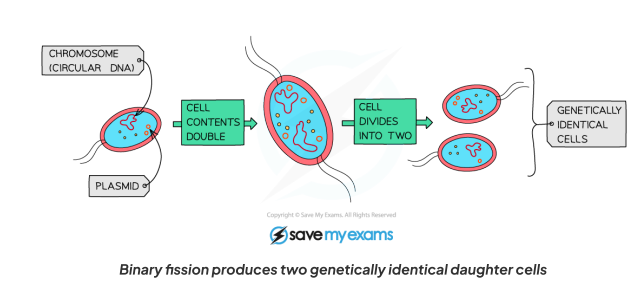
There are mechanisms to ensure that all daughter cells inherit a copy of the single, circular DNA molecule along with some plasmids.

What happens if a daughter cell does not recieve the sinngular circular DNA or at least one copy of a plasmid?
It dies.
Bacteria can divide every ___ minutes under _____ __________.
What does this rapid reproduction allow them to do?
Bacteria can divide every 20 minutes under ideal conditions.
This allows them to:
Colonise new environments quickly
Outcompete other microbes
Accumulate mutations faster, increasing genetic variation (contributing to the issues surrounding antibiotic resistance)
What are viruses?
Viruses are acellular infectious particles.
Do viruses undergo cell division? Why/why not?
No, as they are non-living.
What is the typical structure of a viral particle?
A nucleic acid core (their genomes are either DNA or RNA, and can be single or double-stranded)
A protein coat known as a ‘capsid’
Some viruses have an outer layer known as an ‘envelope’ formed usually from the membrane-phospholipids of a cell they were made in
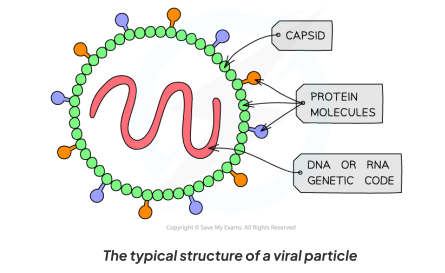
Viruses are non-living and ________ - they can only replicate inside _____ _____.
Viruses are non-living and parasitic - they can only replicate inside host cells.
Describe the process of viral replication.
Attachment proteins bind to complementary receptors on host cell surface.
Viral DNA or RNA is injected into the host cell.
Host cell uses its own enzymes and ribosomes to synthesise viral proteins and nucleic acids.
New viral particles are assembled.
Viruses are released by:
cell lysis (bursting)
budding (takes host membrane – forms viral envelope)
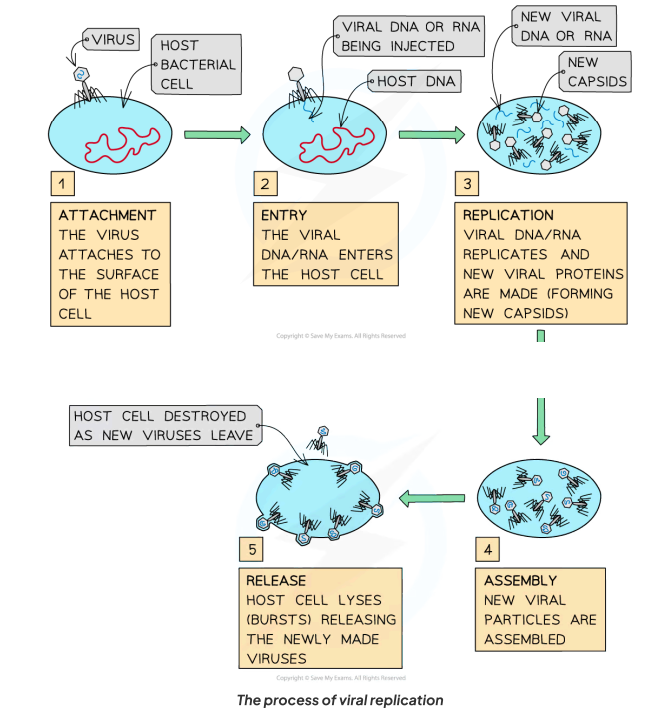

How do viruses cause harm?
Virus release damages or destroys host cells, causing disease.
Different viruses have different __________ ________, and therefore can only bind to ________ host cell types that have the correct (____________) receptor proteins.
Fill in the gaps, then give examples on the concept mentioned.
Different viruses have different attachment proteins, and therefore can only bind to specific host cell types that have the correct (complementary) receptor proteins.
e.g. some viruses use prokaryotic cell hosts, others use eukaryotic.
e.g. some viruses can only infect one specific cell type, whereas others can infect many different types.